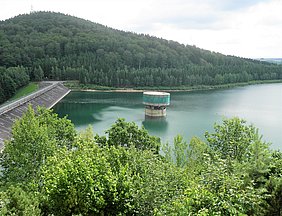Risk management in drinking water supply is an effective instrument to prevent any negative impacts on the safety of water supply.
TZW has developed new methodological approaches for the Saxonian State Reservoir Administration (Landestalsperrenverwaltung, LTV) to implement risk management in the catchment areas of reservoirs. Meanwhile TZW successfully has put them into practice at several, partly complex, reservoir systems of the LTV.
Special emphasis was put on methodological aspects - such as the systematic evaluation of the protective function of the catchment area - as well as strategic-organisational experiences to integrate the relevant actors in the catchment area into the risk management process.
The public drinking water supply in the Free State of Saxony is largely provided by drinking water reservoirs. Their protection is therefore essential in Saxony.
In several sub-projects, the TZW has implemented risk management systems for the realisation of EN 15975-2 ("Safety of drinking water supply - Guidelines for risk and crisis management") for two drinking water reservoirs and a complex reservoir system.
Special focus was laid on the risks affecting water quality. Synergies with upcoming revisions of protection areas according to national guideline DVGW W 102 were used several times.
Systematic hazard analysis
The work included the development and application of a practicable approach for hazard analysis and risk assessment in order to systematically evaluate the hazard and hazardous events in the catchment areas and during raw water abstraction.
New modules were developed to assess the protective function of the catchment area of reservoirs, taking into account the following aspects:
- Site-specific factors influencing the formation of surface or near-surface runoff components.
- Circumstances that inhibit contamination or further transport of contaminants through the water system.
- Retention function of the reservoir’s water body.
In the case of reservoir systems consisting of several reservoirs with water transfer from other catchment areas, the procedure was successfully adapted to the much more complex location and mode of operation.
For the hazardous events recorded, it was determined specifically for each location whether they pose significant risks to the water supply system. The procedure was implemented with a Geographical Information System (GIS), so that the spatial reference of the information, which is indispensable for risk management in the catchment area, was preserved.
Based on the risk assessment, risk control measures were documented and possible need for action was identified.
Project coordination and inclusion of third parties
All steps and assessments were carried out in close coordination with the LTV project team. Stakeholder, like representatives of the relevant authorities and of water and wastewater utilities were closely involved in working groups accompanying the project. Thus, an intensive exchange with all participants and the constructive coordination of the risk management process took place. In working group meetings, interim and final results were presented and discussed.
As a result, the TZW developed a technical proposal for a practicable risk management system, which is now available at the LTV.
Publications:
Sturm, S.; Villinger, F.; Kiefer, J.: Neuer Ansatz zum Risikomanagement für Talsperren-Einzugsgebiete – Teil 1. DVGW energie | wasser-praxis 5, 66 - 73 (2016)
Sturm, S.; Villinger, F.; Kiefer, J.: Neuer Ansatz zum Risikomanagement für Talsperren-Einzugsgebiete – Teil 2. DVGW energie | wasser-praxis 6/7, 80 – 86 (2016)
Sturm, S.; Brauer, F.; Hegewald, T.; Freier, K.: Risk Assessment and Implementing Risk Management for a Complex Drinking Water Reservoir-System in Saxony, Germany. Water Safety Conference 2022. Narvik 22-24 June 2022. Conference Proceedings. pp. 97-98; Editors: International Water Association (IWA), World Health Organization (WHO), UiT the Arctic University of Norway, Chalmers University of Technology, Sweden (2022)

![[Translate to English:] Prüfstelle-Produktprüfung_Teststand Test centre and product testing](/fileadmin/_processed_/0/9/csm_TZW-Karlsruhe_Pruefung_Geraete-Teststand_377188946c.jpg)


























